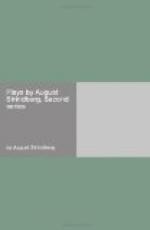Here, as elsewhere, it is made patent that Strindberg’s religiosity always, on closer analysis, reduces itself to morality. At bottom he is first and last, and has always been, a moralist—a man passionately craving to know what is right and to do it. During the middle, naturalistic period of his creative career, this fundamental tendency was in part obscured, and he engaged in the game of intellectual curiosity known as “truth for truth’s own sake.” One of the chief marks of his final and mystical period is his greater courage to “be himself” in this respect—and this means necessarily a return, or an advance, to a position which the late William James undoubtedly would have acknowledged as “pragmatic.” To combat the assertion of over-developed individualism that we are ends in ourselves, that we have certain inalienable personal “rights” to pleasure and happiness merely because we happen to appear here in human shape, this is one of Strindberg’s most ardent aims in all his later works.
As to the higher and more inclusive object to which our lives must be held subservient, he is not dogmatic. It may be another life. He calls it God. And the code of service he finds in the tenets of all the Christian churches, but principally in the Commandments. The plain and primitive virtues, the faith that implies little more than square dealing between man and man—these figure foremost in Strindberg’s ideals. In an age of supreme self-seeking like ours, such an outlook would seem to have small chance of popularity, but that it embodies just what the time most needs is, perhaps, made evident by the reception which the public almost invariably grants “There Are Crimes and Crimes” when it is staged.
With all its apparent disregard of what is commonly called realism, and with its occasional, but quite unblushing, use of methods generally held superseded—such as the casual introduction of characters at whatever moment they happen to be needed on the stage—it has, from the start, been among the most frequently played and most enthusiastically received of Strindberg’s later dramas. At Stockholm it was first taken up by the Royal Dramatic Theatre, and was later seen on the tiny stage of the Intimate Theatre, then devoted exclusively to Strindberg’s works. It was one of the earliest plays staged by Reinhardt while he was still experimenting with his Little Theatre at Berlin, and it has also been given in numerous German cities, as well as in Vienna.
Concerning my own version of the play I wish to add a word of explanation. Strindberg has laid the scene in Paris. Not only the scenery, but the people and the circumstances are French. Yet he has made no attempt whatever to make the dialogue reflect French manners of speaking or ways of thinking. As he has given it to us, the play is French only in its most superficial aspect, in its setting—and this setting he has chosen simply because he needed a certain machinery offered him by the Catholic, but




